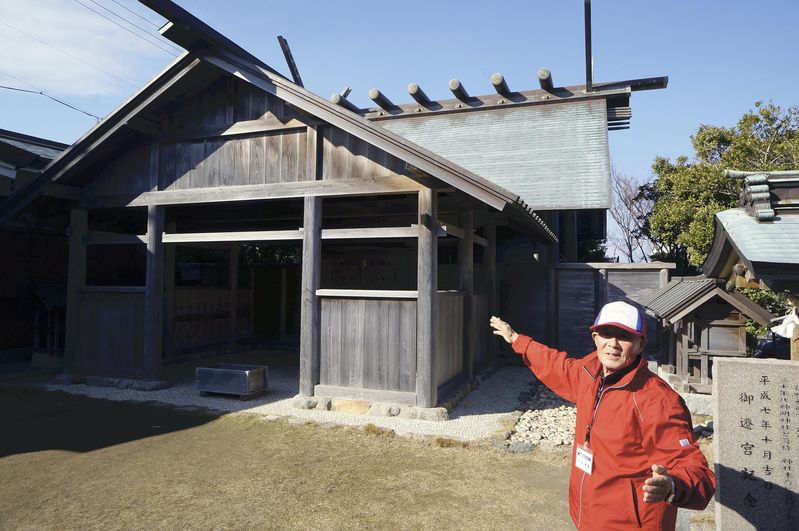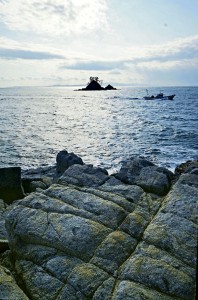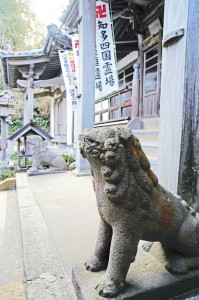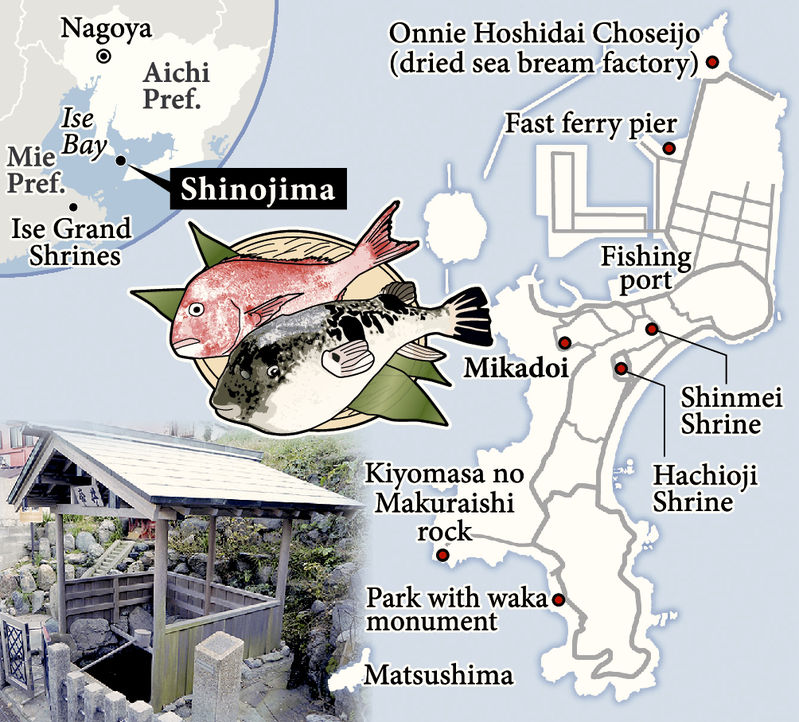
Shinmei Shrine retains the magnificence of the Ise Grand Shrine. Once every year, the male spirit of Hachioji Shrine is said to visit Shinmei Shrine (a female shrine). On that day, all the lights on the island are turned off awaiting the ritual’s end. (all photos courtesy Yomiuri Shimbun)
Pilgrimage to Shinojima island
February 16, 2014 Yoshitaka Tsujimoto / Yomiuri Shimbun Staff Writer
The Yomiuri Shimbun
In the Edo period (1603-1867), travel and transportation were restricted under the Tokugawa shogunate, and the only major trip most people could take was to visit the Ise Grand Shrines in Mie Prefecture once in their lifetimes. Surprisingly, the famous shrines apparently weren’t the final destination for the worshippers.
After visiting the Ise Grand Shrines, pilgrims crossed Ise Bay by boat to reach a shrine on Shinojima island off the Chita Peninsula in Aichi Prefecture. Their worship is completed with their visit to the island shrine. At least, that’s the story passed down on the island, even if the Ise shrines deny the legend. The discrepancy intrigued me.

A stone crisscrossed with gouges left over from an old quarry that used to operate on Shinojima island. Stone used to be shipped from the island to the mainland. Today, the depth of the sea around the quarry attracts anglers.
Amid the gusting winter winds, I disembarked from a high-speed boat onto Shinojima. I noticed a sign reading “The island of onbe-dai and fugu.” Onbe-dai is a salted preparation of sea bream, which is made as an offering for the Ise shrines.
Legend has it that Yamatohime no Mikoto, a daughter of Emperor Suinin, once paid a visit to Shinojima island. The princess, who is said to have established the Ise Grand Shrines, loved sea bream caught near the island so much that she decreed Shinojima to be the sole source of sea bream to be presented at the grand shrines. For more than 1,000 years since, exactly 508 of the chosen sea bream are devoted to the shrines each year, spread across three separate occasions.
Certainly, there must be lean years. But the designated number of sea bream of very specific sizes must be collected for the offering each year. It must be a difficult duty.
“We want to give good fish to the gods. I can’t call it a hard job,” said Yoshichika Kinoshita, 54, of the Shinojima fishery cooperative association, who has been responsible for the work for more than 30 years.
I felt embarrassed for taking it lightly.
The one fishing town on this small island, which has only about 6 kilometers of shoreline, is like a labyrinth. The roads are so narrow that I can touch either side with my arms outstretched. The alleys twist in irregular turns. And at one corner of this labyrinth stands a magnificent shrine—which seems somewhat out of place with the rest of the island’s scenery. It’s the main structure of Shinmei Shrine, which enshrines some of the same gods enshrined at the Ise Grand Shrines.
Shinmei Shrine retains the magnificence of the Ise Grand Shrine. Once every year, the male spirit of Hachioji Shrine is said to visit Shinmei Shrine (a female shrine). On that day, all the lights on the island are turned off awaiting the ritual’s end.
Thanks to this auspicious background, one of the old halls from the Ise Grand Shrines is given to Shinmei Shrine, once every 20 years, in the year following the regular renewal of the Ise shrine halls. That’s why pilgrims in the past headed to Shinojima to pray, and why islanders have passed down the lore.
When Shinmei Shrine receives a new hall from the Ise shrines, its existing hall is moved a short distance to Hachioji Shrine, whose hall will be moved to another shrine in turn. The halls, made of 200-year-old Japanese cypress, have been recycled this way over many long years.

Stone guardians outside the island's shrine
Although Shinojima is a small island, it has a history rich with stories. The tiny island makes an appearance in Manyoshu, a collection of ancient waka poems. A note recorded on a wood strip found in the remains of Heijokyo capital in Nara shows that the island paid tribute to emperors with gifts including dried shark.
During the so-called Nambokucho period (1336-1392) when the Imperial house was split in two, Emperor Gomurakami (1328-1368), who was a prince at that time, famously wound up on the island after encountering misfortune at sea. A well called Mikadoi was dug for the prince during his stay. The well still holds water, whose surface shines black from the bottom of the shaft.
Rocks were hewn from several places on the island during the Edo period for the construction of Nagoya Castle. One of these locations, a cliff on the island’s western coast still retains visible gouges.
Warrior Kato Kiyomasa (1562-1611) ordered workers to bring a rock from the cliff, but it was too heavy to transport and so was left where it was. This rock is now known as “Kiyomasa no Makuraishi.”
“Twenty daimyo feudal lords in western Japan competed with one another to hew rocks from the island. Locals feared ‘the island would lose its shape,’” said Kazuyoshi Miki, 75, a tour guide, adding with a laugh that the people of the island eventually got good compensation from the lords, so they didn’t complain.
Delicious ‘diamonds’
Those daimyo may have licked their lips for another of the island’s specialties: torafugu, or tiger puffer fish. It’s not so well known, but Aichi Prefecture boasted the largest catch of wild torafugu in Japan for three years running, starting in 2001. Shinojima is the main fishing port for the catch. At that time, fugu caught near the island were reportedly sent to Shimonoseki, a Yamaguchi Prefecture city famous for its fugu.
“The fish commanded very high prices during the bubble era. Fishermen cherished them as the ‘diamonds of the sea’ back then,” said Toru Fukubayashi, 55, an adviser for the island’s fisheries cooperative association.
Rather than take everyone’s word for it, I decided to order a course of torafugu dishes at a ryokan inn, to test that reputation with my own taste buds. If Yamatohime no Mikoto had supped on fugu instead of sea bream, I can’t help but think that the offering would be “onbe-fugu” today, not onbe-dai.
I paired the seafood feast with hot sake and had a wonderful time.
******************************************************
From JR Tokyo Station, the Tokaido Shinkansen can take you to Nagoya Station in about 1 hour and 40 minutes. From there, a 50-minute ride on the Meitetsu Nagoya Railroad to Kowa Station, then 30 minutes on a Chita-noriai bus will bring you to Morozaki Port. Get on a Meitetsu Kaijo Kankosen fast ferry and get off at Shinojima Port. The ferry ride is about 10 minutes. For more information, call Shinojima Kanko Kyokai at (0569) 67-3700.


Leave a Reply